A well-fitting bra is the foundation of comfort and confidence. It provides essential support, enhances your silhouette, and ensures all-day ease. Proper fit is key to various activities and body types.
1.1 Why Proper Bra Fit Matters
Proper bra fit is essential for both comfort and health. A well-fitting bra provides adequate support, reducing discomfort and potential long-term damage to skin and tissues. It also enhances posture, boosts confidence, and ensures freedom of movement. Poorly fitting bras can lead to health issues like back pain and restricted breathing. Finding the right fit is a simple yet impactful way to improve daily life, making it a crucial aspect of self-care and personal well-being.
1.2 The Importance of a Well-Fitting Bra
A well-fitting bra is vital for comfort, confidence, and overall well-being. It provides the necessary support to maintain proper posture, reducing the risk of back and shoulder pain. A good fit ensures breasts are secure, preventing discomfort during movement. It also enhances the shape of clothing, boosting self-esteem. Conversely, an ill-fitting bra can lead to health issues, such as skin irritation or restricted breathing. Investing in a bra that fits correctly is a simple yet impactful way to prioritize both physical and emotional well-being, making it an essential part of daily life.
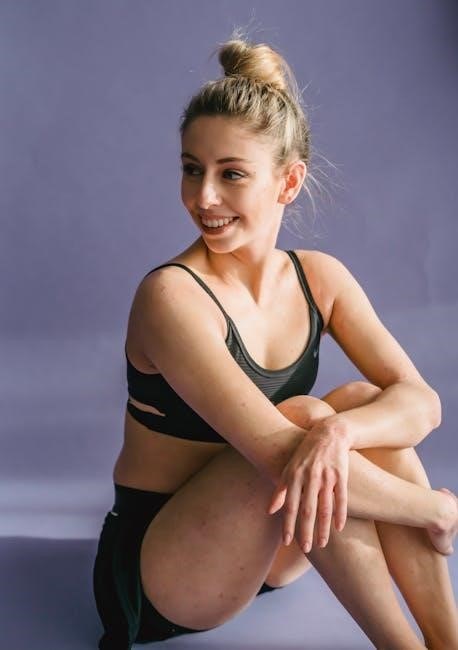
Understanding Bra Size
Bra size combines band and cup measurements, ensuring comfort and support. Accurate sizing enhances posture, reduces discomfort, and boosts confidence for a smooth, confident silhouette.
2.1 Band Size: How It Should Fit
The band should fit snugly around your torso, sitting level and parallel to the floor. It should not ride up or feel too tight, as this can cause discomfort or restrict breathing. To ensure a proper fit, measure around the narrowest part of your torso, just under your bust. The band should provide support without digging into your skin. A well-fitting band stays in place throughout the day, offering stability and comfort. Avoid a band that feels loose, as it may not provide adequate support. Proper band fit is essential for overall bra comfort and effectiveness.
2.2 Cup Size: Finding Your Perfect Fit
Cup size is determined by the difference between your band size and your bust measurement. To find your cup size, subtract your band size from your bust measurement. For example, a 2-inch difference is a B cup, while a 4-inch difference is a D cup. The cups should encapsulate your breasts fully, lying smooth against your skin without gapping or causing overflow. Ensure the fabric is taut but not stretched, and the underwire sits flat against your sternum. Proper cup fit ensures comfort, support, and a natural shape. Try different styles to find what works best for you.
2.3 Bra Size Conversion Charts
Bra size conversion charts are essential for understanding how sizes vary across different regions and brands. For instance, a US 34DD may equate to a UK 32E or an EU 70E. These charts help bridge sizing discrepancies, ensuring a consistent fit globally. They typically include band and cup size equivalencies, allowing you to compare measurements accurately. By referencing these charts, you can determine your size in various international standards, making shopping easier, especially when purchasing from global brands. Regularly updating your measurements ensures the best fit, as sizes can change over time due to factors like weight fluctuations or health changes.
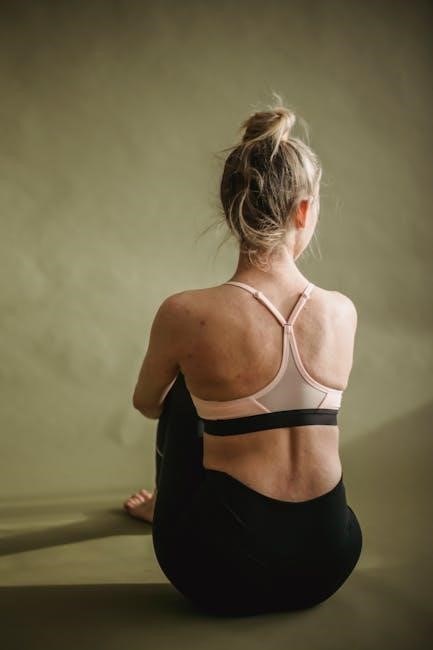
Measuring for Bra Size
Measuring for bra size ensures accuracy and comfort. Use a flexible tape measure around your band and cup. Wear a soft-cup bra for best results.
3.1 How to Measure Your Band Size
To measure your band size, wrap a flexible tape measure around your torso at the narrowest point, just above your bust and below your ribcage. Ensure the tape is level, parallel to the floor, and snug but not tight. The measurement should be taken while standing upright with good posture. If the number is even, that’s your band size; if odd, round up to the nearest even number. Avoid pulling the tape too tight or letting it sag, as this can lead to an inaccurate fit. Proper band measurement is crucial for comfort and support, ensuring your bra stays in place throughout the day.
3.2 How to Measure Your Cup Size
To measure your cup size, first determine your bust measurement by wrapping a tape measure around the fullest part of your bust while wearing a non-padded bra. Subtract your band size from this measurement. The difference determines your cup size: 1 inch equals an A cup, 2 inches a B cup, and so on. For accuracy, keep the tape level and parallel to the floor. Ensure the bra fits snugly and the tape isn’t too tight or loose. This method helps identify the perfect cup size for comfort and support, ensuring a flattering fit for any body type or activity level.
3.3 Using Online Bra Size Calculators
Online bra size calculators simplify the process of finding your perfect fit. These tools use your band and bust measurements to determine your cup size. Many calculators, like those from Cacique and Reddit’s A Bra That Fits, offer step-by-step guides. Simply input your measurements, and the calculator provides your size. They often include charts for international conversions, ensuring accuracy. For best results, measure yourself while wearing a non-padded bra and keep the tape measure level. Online tools are convenient and save time, offering a reliable way to find your size without in-store fittings. Regular updates ensure they reflect current sizing standards, making them a valuable resource for anyone seeking a comfortable and well-fitting bra.
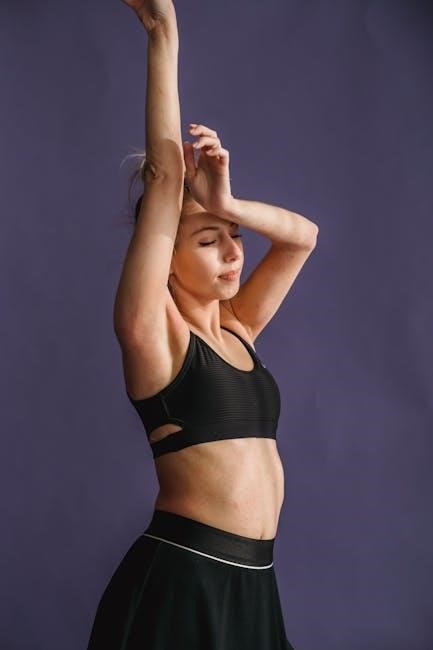
Signs of a Poor Fit
A poor-fitting bra often has a band that rides up or feels too tight, cups that gap or spill over, and shoulder straps that dig into skin.
4;1 The Band: Signs It’s Too Tight or Too Loose
A too-tight band may dig into your skin, causing discomfort or difficulty breathing. If it rides up, it’s likely too small. Conversely, a too-loose band may slip down or shift, failing to provide proper support. Ensure the band sits level and stays in place without restricting movement. If adjustments don’t resolve the issue, it may be time to try a different size or style. A well-fitting band should feel snug but not constricting, offering stability without sacrificing comfort.
4.2 The Cups: Signs of Gapping or Overflow
Gapping occurs when the cups are too large, leaving visible space or wrinkling. Overflow happens when the cups are too small, causing breasts to spill over. If the cups gape, try a smaller cup size. If they overflow, a larger cup size may be needed. Proper fit ensures breasts fill the cups without bulging or leaving gaps. If issues persist, consider a different style, like a full-coverage or balconette bra, to better suit your shape. The cups should lie smoothly against your skin for a seamless look and optimal support.
4.3 The Shoulder Straps: Adjusting for Comfort
Shoulder straps should provide support without digging into your skin. If they feel too tight, they can cause discomfort and poor posture. Adjust the straps to a snug but comfortable fit, ensuring they stay in place without slipping. If the straps consistently slip off, it may indicate a need for a smaller band size or a different bra style. Properly adjusted straps distribute weight evenly, preventing strain on your shoulders. Regular adjustments throughout the day can help maintain comfort and support, ensuring your bra feels as good as it fits.
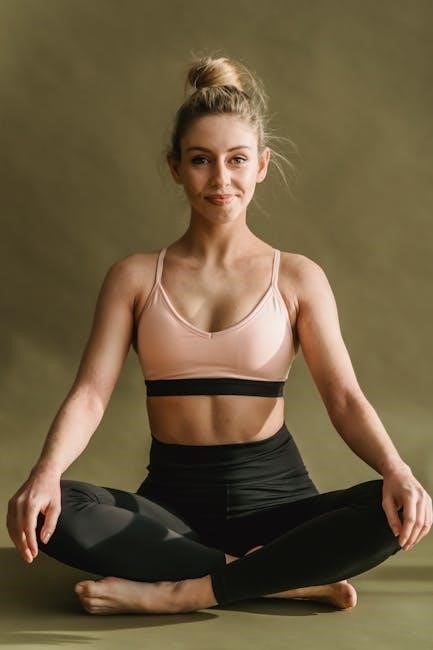
Signs of a Good Fit
A well-fitting bra has a band that sits smoothly, cups that cover without gapping, and straps that adjust for support without digging. It feels secure yet comfortable, allowing freedom of movement and enhancing confidence. Proper fit ensures no slipping, bulging, or discomfort, making it ideal for all-day wear.
5.1 The Band: Comfortable and Secure
The band should feel snug but not restrictive, sitting level around your torso. A well-fitting band stays in place without riding up, providing consistent support. It should be breathable and soft, avoiding irritation. Adjustable straps ensure a customizable fit, while wide bands offer extra stability. Proper band fit ensures the bra stays secure, preventing discomfort and shifting. A band that fits correctly distributes weight evenly, preventing digging or pressure points. This secure fit enhances posture and confidence, making it essential for all-day comfort and support.
5.2 The Cups: Smooth and Contained
The cups should fit smoothly, lying flat against your skin without gapping or wrinkling; They should fully contain your breasts, providing even support and coverage. Properly fitted cups prevent spillage or overflow, ensuring a seamless look under clothing. The fabric should be breathable and soft, offering comfort while maintaining shape. A well-fitting cup aligns with the natural curve of your body, avoiding digging or pressure points. This smooth, contained fit enhances both comfort and confidence, making it essential for everyday wear and various activities.
5.3 The Shoulder Straps: Adjusted for Support
Shoulder straps should be adjusted to provide the right balance of comfort and support. They should not dig into your skin but also shouldn’t be so loose that they slip off. Properly fitted straps distribute the weight evenly, preventing strain on your shoulders. The straps should lie flat against your skin, avoiding bunching or twisting. Adjusting the straps ensures optimal lift and alignment, enhancing both comfort and confidence. A well-adjusted strap contributes to a seamless fit, making it essential for all-day wear and various activities.
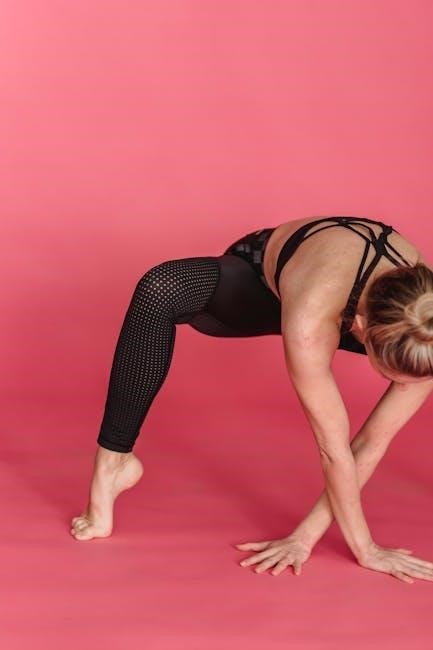
Common Bra Fitting Issues
Many women face issues like bands riding up, cups gapping or spilling over, and shoulder straps digging in. These problems can cause discomfort and affect confidence, but solutions exist.
6.1 The Band Riding Up
The band riding up is a common bra fitting issue, often caused by a band that is too loose or a bra that is the wrong size. This can lead to discomfort and inadequate support. A properly fitting band should sit level and remain in place throughout the day. If the band rides up, it may indicate the need for a smaller band size or a different style. Adjusting the straps or ensuring a snug fit during measurement can help resolve this issue. Professional fittings can also provide personalized solutions for a secure and comfortable fit.
6.2 The Cups Gapping or Spilling Over
Gapping or spilling over in the cups is a common issue that affects both comfort and support. If the cups gap, it may mean the bra is too small or the style isn’t suitable for your breast shape. Conversely, spilling over indicates the cups are too small or the band is too loose, causing the breasts to overflow. To address this, try a larger cup size or a different style, such as a full-coverage bra. Proper fitting ensures the cups lie smoothly against the skin without excess fabric or spillage, providing optimal support and a flattering silhouette.
6.3 Shoulder Straps Digging In
Shoulder straps digging into your skin can cause discomfort and pain throughout the day. This issue often arises when the bra band is too loose, forcing the straps to bear most of the weight. To resolve this, adjust the straps to a comfortable height or consider a bra with wider straps for better distribution of weight. If the problem persists, it may indicate the band size is too large or the bra style isn’t suitable for your body type. Properly fitted straps should provide support without restricting movement or causing pressure.
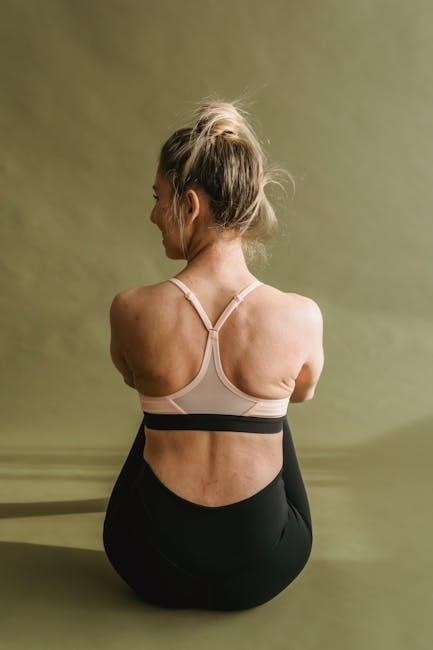
Choosing the Right Bra Style for Your Body Type
Selecting the right bra style for your body type ensures comfort and confidence. Whether you’re petite, full-busted, or athletic, there’s a bra designed to suit your needs perfectly.
7.1 Best Bras for Different Body Types
Choosing the right bra style for your body type ensures optimal comfort and support. For full-busted women, structured bras with wide straps provide excellent lift. Petite frames benefit from demi-cup or balconette styles, while athletic builds may prefer sports bras. Plus-size women often find comfort in bras with wider bands and adjustable straps. T-shirt bras are ideal for smooth coverage under tight clothing. Matching your bra style to your body type enhances confidence, ensures proper support, and creates a flattering silhouette for everyday wear or high-impact activities.
7.2 Bras for Different Activities: Everyday vs. Sports
Choosing the right bra for your activity level is crucial for comfort and support. Everyday bras prioritize comfort with soft fabrics and versatile designs, suitable for casual wear. Sports bras are engineered for high-impact activities, offering sturdy support, breathable materials, and moisture-wicking technology. They minimize movement and reduce discomfort during workouts. Whether you’re running errands or running a marathon, selecting the right bra ensures confidence and performance. Brands like Freya Active and Nala offer expert-recommended options tailored to specific needs, ensuring a perfect blend of support and comfort for any activity.
7.3 Bras for Different Preferences: Lace, T-Shirt, Push-Up
Bras come in various styles to suit personal preferences and occasions. Lace bras offer a delicate, elegant look, ideal for special occasions or those who value aesthetics. T-shirt bras provide seamless coverage and invisibility under tight clothing, making them a practical choice for everyday wear. Push-up bras enhance cleavage, offering a boost for those seeking a more defined silhouette. Each style caters to different needs, ensuring comfort and confidence. Whether you prefer understated simplicity or glamorous detail, there’s a bra design to match your lifestyle and preferences perfectly.
How to Shop for Bras
Shopping for bras involves knowing your size, trying different styles, and using fit guides. Regular measurements and expert advice ensure the perfect fit and comfort for any occasion.
8.1 Tips for In-Store Bra Shopping
For a successful in-store bra shopping experience, start with a professional fitting to determine your accurate size. Try on multiple styles to find what suits your body type and preferences. Ensure the band fits snugly on the loosest hook, and the cups cover your breasts completely. Wear a thin, fitted top to assess how the bra looks under clothing. Don’t hesitate to ask for advice from knowledgeable staff. Check for comfort and support by moving around and bending over. Remember, the right fit should feel natural and stay in place all day.
8.2 Tips for Online Bra Shopping
When shopping for bras online, use detailed size charts and fit guides to ensure accuracy. Check user reviews for insights on fit and comfort. Consider brands offering virtual try-on tools or fit quizzes for personalized recommendations. Look for clear product descriptions, including fabric type and support level. Filter by your preferences, such as cup style or strap type. Don’t hesitate to contact customer service for sizing advice. Finally, review the return and exchange policies to make the process hassle-free if adjustments are needed.
8.3 How to Use a Bra Fit Guide
Start by measuring your band and cup size accurately using a tape measure. Consult the bra fit guide’s size chart to match your measurements. Pay attention to conversion charts for international sizes. Review the guide’s step-by-step instructions for determining your ideal fit. Use the guide to identify your body type and preferred bra style; Check for tips on adjusting straps and ensuring the band sits comfortably. Refer to the guide’s troubleshooting section for common fit issues. Finally, use the guide’s recommendations to explore brands and styles that cater to your needs for optimal comfort and support.
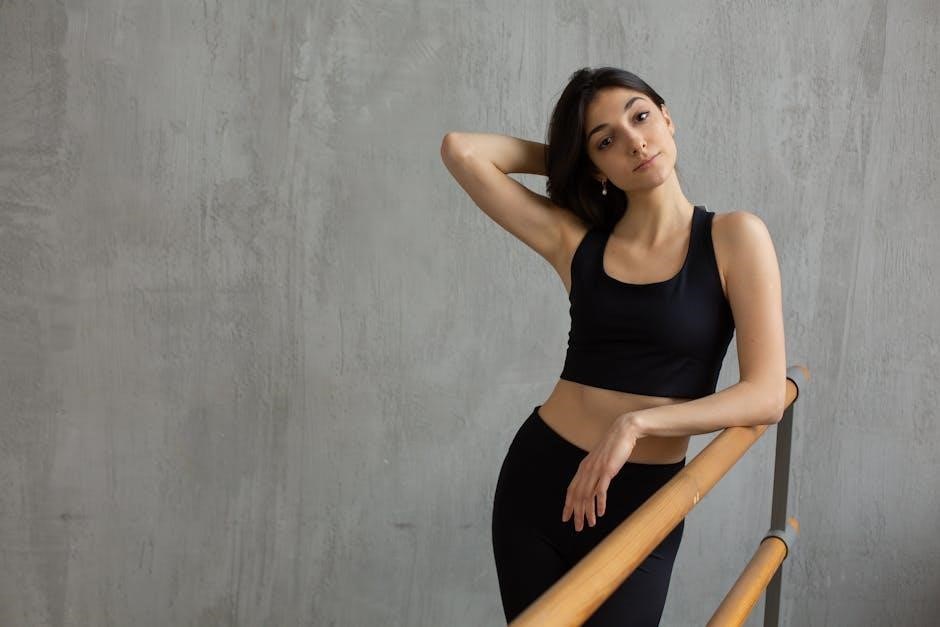
The Role of Bra Fitting in Overall Comfort and Health
A well-fitting bra enhances posture, reduces health risks, and prevents discomfort. Proper support promotes breast health and alleviates pain, ensuring long-term comfort and confidence.
9.1 How a Proper Fit Affects Posture
A well-fitting bra significantly impacts posture by redistributing weight evenly, reducing strain on the shoulders and back. Proper support lifts the bust, aligning the spine naturally and improving overall alignment. A bra that fits correctly prevents the shoulders from hunching forward, promoting a straighter posture. Additionally, it reduces muscle fatigue, allowing for better movement and comfort throughout the day. A good fit ensures the band sits level and the straps don’t dig in, further enhancing posture benefits. This creates a more confident and healthy stance, essential for long-term comfort and well-being.
9.2 The Link Between Bra Fit and Breast Health
A proper-fitting bra plays a crucial role in maintaining breast health. It provides necessary support, reducing strain and discomfort. A well-fitting bra prevents issues like skin irritation, chafing, and restricted lymph flow, which can lead to health complications. Ill-fitting bras, especially those that are too tight, can cause discomfort and potentially damage breast tissue over time. Ensuring a bra fits correctly helps promote healthy blood circulation and prevents long-term breast-related issues. Regular fit checks and updates are essential to maintain optimal breast health and overall well-being.
9.3 Avoiding Discomfort and Pain
A well-fitting bra is essential to avoid discomfort and pain. Tight bands can cause skin irritation and restricted breathing, while shoulder straps digging into skin can lead to neck and back pain. Properly fitted cups prevent chafing and overflow, reducing the risk of discomfort. Ensuring the bra does not ride up or gap is crucial for all-day ease. Regular fit checks and adjustments help maintain comfort, preventing long-term issues like poor posture or muscle strain. A bra that fits correctly promotes overall comfort and well-being, making it a vital part of daily wear.

Maintenance and Care of Bras
Proper care extends bra longevity. Hand wash with mild detergent, avoid hot water, reshape while wet, and store flat. Replace bras when elasticity or support fades.
10.1 How to Wash Your Bras for Longevity
Proper washing ensures bras lasts longer; Hand wash in cold water with mild detergent to preserve elasticity and fabric quality. Avoid hot water, bleach, or fabric softeners, as these can damage materials. Gently scrub and rinse thoroughly. Reshape while wet to maintain form and lay flat to air dry. Avoid machine washing or drying, as heat and agitation can stretch or ruin the bra. For delicate or lace bras, use a soft mesh laundry bag if machine washing is necessary. Regular care maintains support and extends the life of your bras.
10.2 Storing Bras to Maintain Shape
Proper storage preserves the shape and extends the life of your bras. Avoid folding or stretching them, as this can misshape the cups or underwire. Store bras in a cool, dry place, away from direct sunlight. Nesting bras (placing one inside another) helps maintain their form. Use a drawer organizer or divider to keep them separate and prevent stretching. For delicate or lace bras, consider storing them in a protective case or pouch to avoid damage. Avoid overcrowding, as this can cause deformation. Proper storage ensures your bras remain supportive and look their best.
10.3 Knowing When to Replace Your Bra
Knowing when to replace your bra is crucial for maintaining comfort and support. Signs that your bra needs replacing include a stretched band that no longer stays in place, cups that no longer fit properly, or underwire poking through. If the bra shows visible wear, such as frayed straps or faded fabric, it’s time for a new one. Most bras should be replaced every 6-12 months, depending on usage and quality. Regularly inspecting your bras ensures you continue to enjoy optimal fit, comfort, and confidence.

Expert Tips and Tricks
Experts recommend regular fittings, adjusting straps daily, and using hacks like extender hooks for a better fit. Professional guidance ensures optimal comfort and support.
11.1 Getting a Professional Bra Fitting
A professional bra fitting ensures accuracy and confidence. Trained fitters measure and assess your shape, providing personalized recommendations. They help you find the perfect size and style, enhancing comfort and support. Regular fittings are crucial as body changes occur. Experts often suggest wearing a non-padded bra for precise measurements. This service is available in-store and offers a tailored experience, addressing specific needs like posture and activity levels. Many women find it transformative, improving both fit and overall satisfaction with their bras.
11.2 Adjusting Your Bra Throughout the Day
Adjusting your bra throughout the day can make a significant difference in comfort and support. Start by ensuring the shoulder straps are snug but not digging into your skin. Check the band to ensure it’s level and not riding up, as this can cause discomfort. Smooth out any wrinkles in the cups to prevent gapping or spillage. If the bra feels too tight or loose, tweak the hooks or straps accordingly. Regular adjustments help maintain proper fit and prevent issues like digging or shifting. This simple habit ensures all-day comfort and optimal support.
11.3 Hacks for a Better Fit
For a better fit, try these practical hacks: Use a bra fit guide to ensure accuracy when measuring. Regularly check and adjust your bra size, as it can change over time. When trying on bras, fasten them on the loosest hook to allow for stretch. Ensure the band lies flat and doesn’t ride up. If the cups gape, consider a smaller size. For spillage, opt for a larger cup size. Adjust shoulder straps to distribute weight evenly. Experiment with different styles, like T-shirt or push-up bras, to find what suits your body best. These tips ensure a comfortable and flattering fit.
Achieving a perfect bra fit enhances comfort, confidence, and overall well-being. Regular checks and professional fittings ensure optimal support and health. Prioritize proper fit for lasting benefits.
12.1 The Importance of Regular Bra Fit Checks
Regular bra fit checks are essential to ensure ongoing comfort and support. Bodies change due to weight fluctuations, hormonal shifts, or aging, affecting fit; Bras also stretch or lose shape over time. Checking fit every 6 months helps maintain proper support, preventing discomfort and posture issues. It’s crucial to replace bras when they no longer fit well. Professional fittings can provide accurate assessments, ensuring your bra continues to meet your needs. Prioritizing regular checks promotes long-term breast health and confidence.
12.2 Final Thoughts on Achieving a Perfect Fit
Achieving a perfect bra fit is a journey worth investing time in. Proper fit enhances comfort, confidence, and overall well-being. By understanding your size, trying different styles, and seeking expert advice, you can find bras that support and flatter your body. Regular fit checks and updates to your wardrobe ensure long-term satisfaction. Remember, everyone’s body is unique, and the right fit can make a significant difference. Prioritize your comfort and health—your perfect fit is out there, and it’s worth the effort to find.


